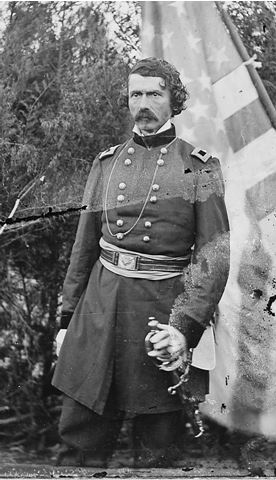1815-1881
Attorney General of New York, 1866-1867
John Henry Martindale was born in Sandy Hill, Washington County, New York, on March 20, 1815. He graduated from the United States Military Academy at West Point in 1835, was appointed a brevet second lieutenant, and served in the Mexican War. The following year, he resigned from the Army to study law, was admitted to the bar in 1838, and commenced practice in Batavia, New York.
Martindale was the District Attorney of Genesee County from 1842 to 1846, and from 1848 to 1851. His career was most notable for his advocacy for the Tonawanda Native American tribe of Western New York, and his representation of John Blacksmith, who sued agents of the Ogden Land Company when he was forcibly evicted from his sawmill by the Company’s agents. The case was decided in favor of Blacksmith. Martindale continued his representation during the appeal to the New York Court of Appeals and, subsequently, to the United States Supreme Court (Fellows v. Blacksmith, 60 U.S. [19 How.] 366 [1857]). Justice (and former Judge of the New York Court of Appeals) Samuel Nelson delivered a unanimous opinion in favor of Blacksmith, affirming the New York Court of Appeals decision in the case. In a second Seneca case (New York ex rel. Cutler v. Dibble, 62 U.S. (21 How.) 366 [1858]), the Supreme Court of the United States upheld the decisions of the New York Courts that held constitutional the 1821 New York statute that prohibited non-Indians from settling or residing on lands belonging to or occupied by the Seneca and provided that the County Court should issue a warrant directing the sheriff to remove such persons.
In August 1861, Martindale was commissioned a brigadier general of volunteers in the Union Army, and participated in all the battles of the Peninsula Campaign in V Corps. After the retreat from Malvern Hill, he was brevetted a major general of volunteers, and appointed Military Governor of Washington, D.C., a post he held from November 1862 to May 1864. While commanding the Military District of Washington in January 1863, General John H. Martindale informed a Maryland slaveholder that he was prohibited from surrendering fugitives, but was required to extend military protection to all fugitives as “Captures of War,” and slaveholders sustaining losses could apply to Congress for compensation.
Afterward he returned to field service, fighting with the XVIII Corps in the Bermuda Hundred Campaign, the Battle of Cold Harbor and the Siege of Petersburg, commanding the corps briefly in mid-July 1864. In September 1864, he resigned his commission because of ill health.
John H. Martindale was elected New York State Attorney General and held office during the years 1866 and 1867. In 1877, one of his clients tried to shoot him at his law office in Rochester, New York.
John Martindale died in Nice, Alpes-Maritimes, France, and was buried at the Batavia Cemetery in Batavia, New York.
Sources
The Death List of a Day: A Gallant Soldier and Able Lawyer Gone. New York Times, December 14, 1881.
Laurence M. Hauptman. Tonawanda Senecas’ Heroic Battle against Removal (2011).
Robert Harrison. Washington during Civil War and Reconstruction: Race and Radicalism (2011).
An Enraged Client: The Attempt of John G. Manning to Murder Gen. J.H. Martindale in Rochester. New York Times, November 26, 1877.

